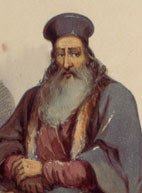It's even more specific stating that we should not kneel from the point of the entrance of the clergy during the lychnikon on Saturday evening until the entrance of the clergy during the lychnikon on Sunday evening.
This has to do with the penitential character of evening worship and its appropriateness on the day of the Resurrection or, as is now the case, during the period of the Joyful Triodion or Pentekostarion. The canon is not primarily concerned with the D. Liturgy.
The first point of patristic phronema to research is the connection of the beginning of the liturgical day as a time when the Lord sends forgiveness to those who repent for the days works (i.e. Apostolic Constitutions VIII, 34-5; Basil the Great, Great Rule 37—PG 31, 1016; Theodore the Studite, Interpretation of Presanctified—PG 99, 1688c). Also, read closely the evening prayers of the Church, whether they be from the Vespers or even the simple pocket daily prayer books.
Now, it is important not to get too scholastic about the issue. Typikon, first and foremost, is imitation. The earliest 'rules' for liturgical life even before the appearance of Typika—foundational or liturgical—are the imitation of the prayer of the holy fathers and saints (i.e. Basil, Pachomius) and the monastic practices joined with the Antiochian, Jerusalemite and, later, Constantinopolitan practices.
The fact that repentance in the American Church—especially the Greek—is a relatively new phenomenon (a greatly few of the faithful are familiar with the mystery of confession and repentance) most do not comprehend the penitential character of the vespers, hence, it is impossible to understand the Resurrectional character of the Pentekostarion period or even a 'simple' Sunday! In this way, all kinds of 'reasons' for it's ok to kneel on Sunday can be devised. The simple fact is that a specific liturgical practice has come down to us.
Another story. When I was in the Atlanta Diocese (GOA) I would normally chant in the Diocesan Church of the Archangel Michael when there were clergy meetings. It happened to be a Saturday morning and like most, the orthros called for Ainoi, Small Doxology, Aposticha, etc. Once we began reading the small doxology a priest stuck his head out the North Door to angrily shout: "We're going to have liturgy; that means we chant the Great Doxology. This is America!" He was a visiting priest and not even the celebrant. Needless to say, no one payed any attention, neither the bishop nor the other priests, but it does illustrate how the dynamics and variety of celebration from the daily to the Resurrectional services are in danger of being forgotten in the US, anyway. Most clergy, lower or higher, only go to Church and pray/serve on feast days. Hence, they've never seen a 'normal' weekday service. The dynamic of a celebrated saint or feast is fuzzy (enough of this).
Back to your topic. As for the group of questions at the end of your snip, the question of continuity is not threatened with the kneeling in conjunction with ordination on a Sunday or during Pentekostarion. If one goes to confess during Pentekostarion he or she will kneel for the prayer of forgiveness. The opportunity with your research is to rediscover the penitential character of the 'Evening Sacrifice' and you have all the troparia of the Great Parakletike, the writings of the fathers and the mystical prayers of the priest for the vespers. Add the instances of penitence in the Scriptures and you've got alot at your fingertips I think. A final and most beautiful source would also be the actual 'kneeling prayers' for the Vespers of the Holy Spirit!
skip to main |
skip to sidebar

Ancient Chant in a Postmodern World
Subscribe Now: standardSmall
Blog Archive
Links
About Me

- FRCJT
- I was born in East St Louis, Illinois in 1961 and grew up in South St Louis, Missouri. I abandoned the music program at Southern Illinois University after deciding to study theology. To this end I enrolled at Hellenic College, Holy Cross Greek Orthodox School of Theology and received the BA and MDiv degrees from these schools. From there I received scholarships to complete a doctoral dissertation in Byzantine Musicology at the School of Theology of the National and Capodistrian University of Athens, Greece, from which I received the ThD in the year 2000; my dissertation was published in the Meletai series of the Institute of Byzantine Musicology. Most dear to my heart is the family I have been blessed with: my wife Diann, my daughter, Maria, and one unborn child God decided to keep for Himself. Presently, I live on the island of Aegina with my family and where I presently sit and write my psaltic musings.